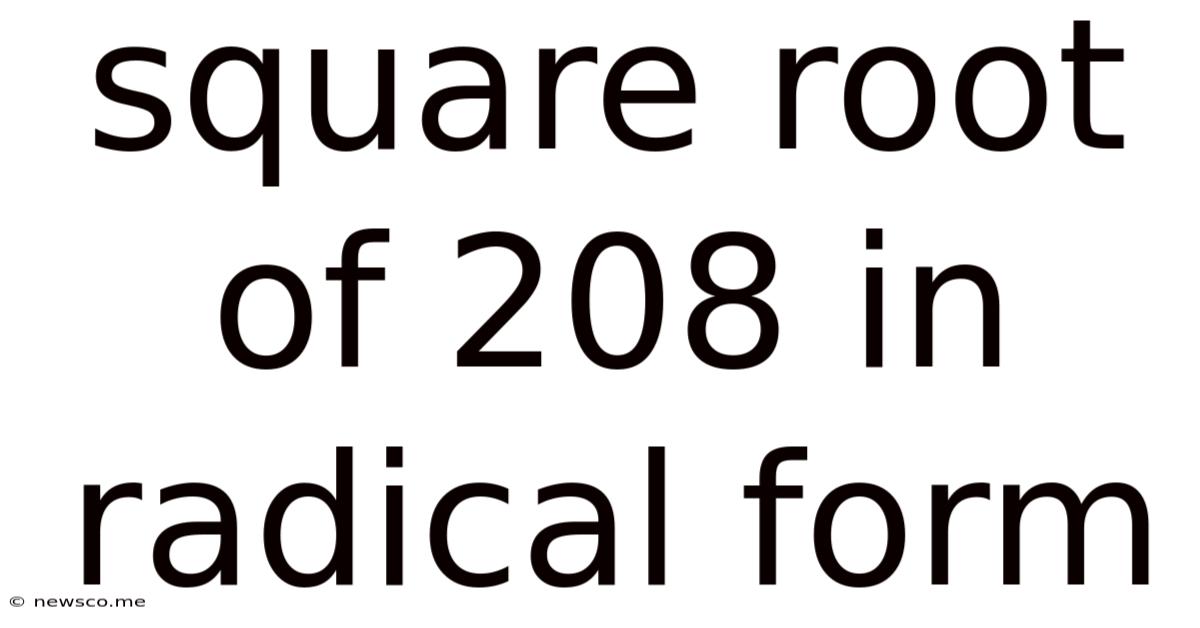Square Root Of 208 In Radical Form
News Co
May 08, 2025 · 4 min read

Table of Contents
Unveiling the Mysteries of √208: A Deep Dive into Radical Simplification
The square root of 208, denoted as √208, might seem like a simple mathematical expression. However, understanding how to simplify it into its most radical form reveals a fascinating journey into the world of prime factorization and radical manipulation. This comprehensive guide will not only provide you with the solution but also equip you with the knowledge and techniques to tackle similar problems with confidence. We'll explore the underlying concepts, provide step-by-step solutions, and delve into the broader mathematical context.
Understanding the Concept of Radical Simplification
Before we embark on simplifying √208, let's clarify what radical simplification means. Essentially, it involves reducing a radical expression to its simplest form by removing any perfect square factors from under the radical sign (√). This process enhances readability, simplifies further calculations, and ensures the expression is presented in its most concise and efficient manner.
Key Principle: The simplification relies on the fundamental property of square roots: √(a * b) = √a * √b, where 'a' and 'b' are non-negative numbers.
Prime Factorization: The Cornerstone of Simplification
The key to simplifying radical expressions like √208 lies in the process of prime factorization. Prime factorization involves breaking down a number into its prime factors – numbers that are only divisible by 1 and themselves (e.g., 2, 3, 5, 7, 11, etc.).
Let's perform the prime factorization of 208:
- 208 ÷ 2 = 104
- 104 ÷ 2 = 52
- 52 ÷ 2 = 26
- 26 ÷ 2 = 13
Therefore, the prime factorization of 208 is 2 x 2 x 2 x 2 x 13, which can be written as 2<sup>4</sup> x 13.
Simplifying √208 Step-by-Step
Now that we have the prime factorization of 208, we can apply it to simplify the square root:
-
Substitute the prime factorization: Replace 208 with its prime factorization: √(2<sup>4</sup> x 13)
-
Apply the square root property: Since √(a * b) = √a * √b, we can separate the terms: √(2<sup>4</sup>) x √13
-
Simplify the perfect square: The square root of 2<sup>4</sup> (which is 2 x 2 x 2 x 2 = 16) is 2<sup>4/2</sup> = 2<sup>2</sup> = 4. Therefore, the expression simplifies to: 4√13
Therefore, the simplified radical form of √208 is 4√13.
Practical Applications and Further Exploration
The simplification of square roots, like the one we've just completed for √208, isn't just an academic exercise. It finds numerous applications in various fields, including:
- Geometry: Calculating the lengths of diagonals in squares and rectangles often involves simplifying radical expressions.
- Physics: Many physics equations, particularly those involving vectors and forces, involve square roots. Simplifying these expressions is crucial for efficient calculations and problem-solving.
- Engineering: Engineering designs frequently rely on precise calculations involving square roots. Simplification helps to ensure accuracy and efficiency.
- Computer Graphics: Rendering and animation techniques often utilize square roots in calculations related to distance, position, and transformations.
Tackling More Complex Radical Expressions
The techniques used to simplify √208 can be extended to more complex radical expressions. Let's consider a few examples:
Example 1: √72
- Prime factorization of 72: 2<sup>3</sup> x 3<sup>2</sup>
- √(2<sup>3</sup> x 3<sup>2</sup>) = √(2<sup>2</sup> x 2 x 3<sup>2</sup>) = √(2<sup>2</sup>) x √(3<sup>2</sup>) x √2 = 2 x 3 x √2 = 6√2
Example 2: √128
- Prime factorization of 128: 2<sup>7</sup>
- √(2<sup>7</sup>) = √(2<sup>6</sup> x 2) = √(2<sup>6</sup>) x √2 = 2<sup>3</sup>√2 = 8√2
Example 3: √(18x²y³)
- Prime factorization: 2 x 3<sup>2</sup> x x<sup>2</sup> x y<sup>2</sup> x y
- √(2 x 3<sup>2</sup> x x<sup>2</sup> x y<sup>2</sup> x y) = 3xy√(2y)
Advanced Techniques and Considerations
While the basic principle of prime factorization forms the foundation, certain advanced techniques can further streamline the process of radical simplification. These include:
- Recognizing perfect square factors quickly: With practice, you'll develop the ability to identify perfect squares within larger numbers more readily, accelerating the simplification process.
- Using a factor tree: A factor tree is a visual aid that helps to systematically break down a number into its prime factors.
- Working with variables: Extending the simplification techniques to include algebraic expressions with variables requires careful attention to exponent rules.
Conclusion: Mastering Radical Simplification
Mastering the art of radical simplification, exemplified by our detailed exploration of √208, is a crucial skill in mathematics and its various applications. By understanding the principles of prime factorization and applying the fundamental properties of square roots, you can confidently tackle even the most complex radical expressions. This process not only simplifies calculations but also deepens your understanding of fundamental mathematical concepts. The practice and application of these techniques will build your mathematical fluency and confidence, opening up a world of opportunities in further mathematical explorations. Remember, practice is key – the more you work with radical expressions, the more proficient you'll become.
Latest Posts
Latest Posts
-
3 4 As A Fraction In Simplest Form
May 08, 2025
-
What Fraction Is Equal To 0 06
May 08, 2025
-
Is 69 A Prime Number Or A Composite Number
May 08, 2025
-
Coordinate Plane Word Problems Worksheet Pdf
May 08, 2025
-
What Is The Opposite Of Multiplication
May 08, 2025
Related Post
Thank you for visiting our website which covers about Square Root Of 208 In Radical Form . We hope the information provided has been useful to you. Feel free to contact us if you have any questions or need further assistance. See you next time and don't miss to bookmark.